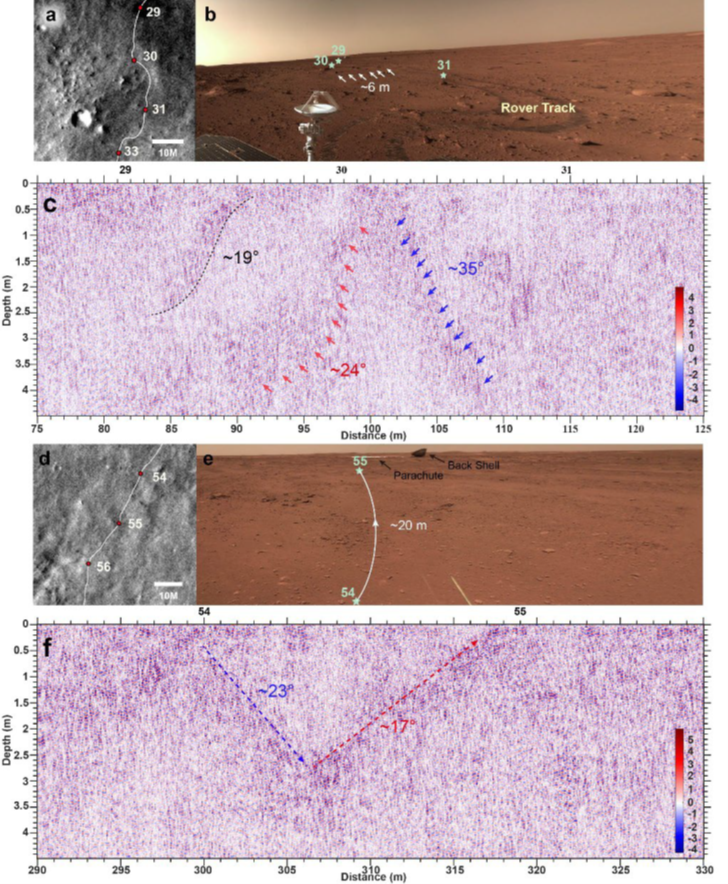China's Zhurong rover reveals complex layers beneath the surface of Mars
New glimpses into the Martian subsurface reveal buried craters and other features.

China's Zhurong rover has provided one of the few peeks into what lies below the surface of Mars.
Data returned by Zhurong's ground-penetrating radar instrument reveals evidence of craters buried just under the surface of Mars and other, sloping features with less certain origins, according to a new paper.
This view of the Martian surface, which shows several clear features, contrasts starkly with the shallow subsurface structure of Earth's moon, also revealed by ground-penetrating radars. The moon's uppermost 33 feet (10 meters) consists of fine layers that have been ground up by a bombardment of micrometeorite strikes.
Related: Will China's Zhurong Mars rover wake up from its worrying hibernation?
The difference may be explained by Mars' thin atmosphere, which offers protection against micrometeorites and also has weathering effects on the surface.
"We found a lot of dunes on the surface at the landing site, so maybe this crater was quickly buried by the sand and then this cover reduced space weathering, so we can see the full shape of these craters' walls," Yi Xu, the lead author on the study, said in a statement.
Zhurong launched in July 2020 along with the Tianwen 1 mission orbiter and landed in the large plain of Utopia Planitia in May 2021. The rover traveled 6,302 feet (1,921 meters) south from its landing site over the following Earth year.
Get the Space.com Newsletter
Breaking space news, the latest updates on rocket launches, skywatching events and more!
The landing site was selected for engineering and science criteria, with the area thought to host shorelines of a possible ancient ocean. One objective for Zhurong's ground-penetrating radar — which pings electromagnetic signals off subsurface rocks and collects their reflections — was seeking evidence of water or ice trapped below the surface.
It uses two different frequency ranges, with the frequency used for this study providing fine detail but only to a depth of around 15 feet (4.5 m). No water was found in this study, but the other radar frequency reaches down to around 260 feet (80 m).

Researchers hope that opening this window onto the subsurface of Mars will provide insight into Mars's geological development, clues about earlier climate conditions and possibly evidence of the presence of water or ice. NASA's Perseverance also carries a ground-penetrating radar instrument, providing new insights into its environs, the floor of Mars' Jezero Crater.
The research article was published on Feb. 9 in the journal Geology of the Geological Society of America.
Meanwhile, the fate of the Zhurong rover itself is currently unknown. The solar-powered rover entered hibernation in May 2022 due to the approaching winter in Mars' northern hemisphere. It was expected to resume activities autonomously in December, but Chinese space authorities have not commented on the rover's apparent silence.
NASA's Mars Reconnaissance Orbiter recently imaged Zhurong from orbit, showing that the rover has not moved since its hibernation period began. The rover could awaken as heat and light conditions improve in Utopia Planitia.
Follow us on Twitter @Spacedotcom and on Facebook.
Join our Space Forums to keep talking space on the latest missions, night sky and more! And if you have a news tip, correction or comment, let us know at: community@space.com.

Andrew is a freelance space journalist with a focus on reporting on China's rapidly growing space sector. He began writing for Space.com in 2019 and writes for SpaceNews, IEEE Spectrum, National Geographic, Sky & Telescope, New Scientist and others. Andrew first caught the space bug when, as a youngster, he saw Voyager images of other worlds in our solar system for the first time. Away from space, Andrew enjoys trail running in the forests of Finland. You can follow him on Twitter @AJ_FI.









